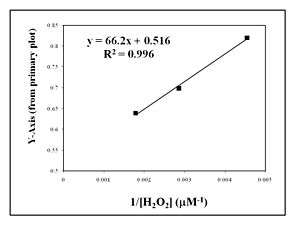Secondary plot (kinetics)
In enzyme kinetics, a secondary plot uses the intercept or slope from several Lineweaver-Burk plots to find additional kinetic constants.
For example, when a set of v by [S] curves from an enzyme with a ping–pong mechanism (varying substrate A, fixed substrate B) are plotted in a Lineweaver–Burk plot, a set of parallel lines will be produced.
The following Michaelis–Menten equation relates the initial reaction rate v0 to the substrate concentrations [A] and [B]:
The y-intercept of this equation is equal to the following:
The y-intercept is determined at several different fixed concentrations of substrate B (and varying substrate A). The y-intercept values are then plotted versus 1/[B] to determine the Michaelis constant for substrate B,  , as shown in the Figure to the right. The slope is equal to
, as shown in the Figure to the right. The slope is equal to  divided by
divided by  and the intercept is equal to 1 over
and the intercept is equal to 1 over  .
.

Secondary Plot in Inhibition Studies
A secondary plot may also be used to find a specific inhbition constant, kI.
For a competitive enzyme inhibitor, the apparent Michaelis constant is equal to the following:
The slope of the Lineweaver-Burk plot is therefore equal to:
If one creates a secondary plot consisting of the slope values from several Lineweaver-Burk plots of varying inhibitor concentration [I], the competitive inhbition constant may be found. The slope of the secondary plot divided by the intercept is equal to 1/kI. This method allows one to find the kI constant, even when the Michaelis constant and vmax values are not known.
References
- A. Cornish-Bowden. Fundamentals of Enzyme kinetics, Rev. ed., Portland: London, England, (1995) pp. 30-37, 56-57.
- The Horseradish Peroxidase/ o-Phenylenediamine (HRP/OPD) System Exhibits a Two-Step Mechanism. M. K. Tiama and T. M. Hamilton, Journal of Undergraduate Chemistry Research, 4, 1 (2005).
- J. N. Rodriguez-Lopez, M. A. Gilabert, J. Tudela, R. N. F. Thorneley, and F. Garcia-Canovas. Biochemistry, 2000, 39, 13201-13209.
![\begin{align}
\frac{1}{v_0} &= \frac{ K_M^A}{v_\max {[}A{]}}+\frac{ K_M^B}{v_\max {[}B{]}}+\frac{1}{v_\max}
\end{align}](../I/m/d72f083a7fa96b7c5bfb2f6796ad123b.png)
![\begin{align}
\mbox{y-intercept} = \frac{ K_M^B}{v_\max {[}B{]}}+\frac{1}{v_\max}
\end{align}](../I/m/86f9ef1561d6f2824bcb35530ee236fd.png)
![\begin{align}
\mbox{apparent } K_m=K_m\times \left(1+\frac{[I]}{K_I}\right)
\end{align}](../I/m/9e43286038ef1026b2de26e7ce7addb7.png)
![\begin{align}
\mbox{slope} =\frac{K_m}{v_\max}\times \left(1+\frac{[I]}{K_I}\right)
\end{align}](../I/m/5236529417a44d6cc33fca5099391a35.png)